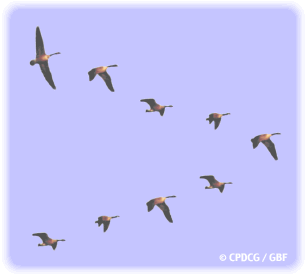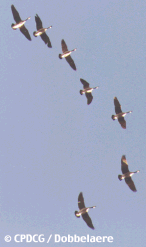Home | Airshows | The Hangar | Nostalgia | f4's F4s | Wattisham Chronicles | Links |
| Of Wild
Geese and Harriers
John Partridge (no relation) finds an unexpected airshow in the depths of January.
I had walked around the eastern end of Rutland Water, the man-made lake in England's smallest county, and stopped for a break at Whitwell where a sheltered bay provided welcome cover from the cold easterly wind. The familiar sound of Pegasus engines drew my attention to the winter sky over nearby RAF Cottesmore. Three Harrier GR7s in loose formation flew a long, lazy circuit west and north before turning east and sinking slowly out of sight. As their sound died away I heard a slapping sound on the water in the bay. I turned my head and was treated to the sight of a whole squadron of Canada geese lunging forward, striving for take-off speed. Soon they were airborne and within seconds the leader was above me, flying into wind on an easterly heading at about thirty feet. The remainder of the squadron followed at the same height slightly behind and on either side of the leader, each member of the formation banking slightly and straightening out to correct its position. A loud squawk from the leader was understood by all, and seconds later the squadron, now in perfect Vic formation, made a 180 degree turn to port. As it flew the downwind leg the squadron reduced power, yet still gained groundspeed. Alert eyes searched out the threshold of the unmarked runway on the water, and before long another squawk signalled the turn onto base leg. Keeping station perfectly, the squadron turned into wind for very short finals, the inside man almost pivoting on the spot while the outside one swept around on a wider track. With increased angle of attack, leading edge slats deployed and noses drooped, the squadron lost height rapidly into wind. The combined undercarriage and air brakes were deployed in unison, the whole squadron flared simultaneously and, after the shortest of landing runs, came to a full stop after the most perfect formation landing I have ever seen. Unlike the Red Arrows, who land singly, and the Spanish Patrulla Aguila, who land in formation but stepped with the rearmost group touching down before the leaders, No 1 (Canada Goose) squadron all alight simultaneously. Of course, they do have a wider runway relative to their size and the braking action of their runway minimises the risk of collision once they have touched down. They are, however, much more prone to FOD than other display teams and they have no organised system of runway clearance. It should also be borne in mind that all circuits are flown entirely under the control of the flight leader - there is no air traffic control nor even a runway controller in a caravan. One advantage this goose squadron clearly has is that there is no need for a bird scaring system, and bird strikes are unheard of.
I could hardly believe my luck when, seconds after No 2 squadron touched down, a third began its take-off run. I identify this squadron as No 3 (R) squadron because the pattern was quite different. They were further to my left and so did not pass over my head on take-off. Furthermore, to my surprise they flew a right hand circuit. There was a considerable amount of squawking, and even when the first turn had been completed the formation was rather ragged. I was also surprised that when they were downwind two of the wingmen on the left of the loose formation maintained power. I was convinced that while the rest turned base these two intended to do a run and break, but in fact they tuned base with the rest, having first gained height to bleed off speed. The resulting landing was more ragged than those performed by the previous two squadrons, but a good attempt at a formation landing nonetheless. All became still and quiet. No movement nor sound came from the direction of Cottesmore. The RAF's Harriers had clearly been outclassed and outperformed, and they were wisely keeping their heads down. It will undoubtedly take JSF to restore the balance, and until it arrives the three squadrons of Canada geese of No 1 (Rutland Water) Wing are the premier aerial display team of this country, and the only one to perform during the winter.
|

 Who gave the signal I do not know, but no sooner had No 1 squadron
landed than No 2 began its take-off run, wingtips slapping the water. Inter-squadron
rivalry was very apparent because this squadron, keen to impress, flew even lower over my
head, the faces of individual members clearly visible. Pre-flight briefing had obviously
been thorough and there was no deviation from the flight plan, because this squadron
followed exactly the same track and carried out just the one circuit, flying a carbon copy
of that flown by No 1 squadron. Again, the formation landing was faultless.
Who gave the signal I do not know, but no sooner had No 1 squadron
landed than No 2 began its take-off run, wingtips slapping the water. Inter-squadron
rivalry was very apparent because this squadron, keen to impress, flew even lower over my
head, the faces of individual members clearly visible. Pre-flight briefing had obviously
been thorough and there was no deviation from the flight plan, because this squadron
followed exactly the same track and carried out just the one circuit, flying a carbon copy
of that flown by No 1 squadron. Again, the formation landing was faultless.